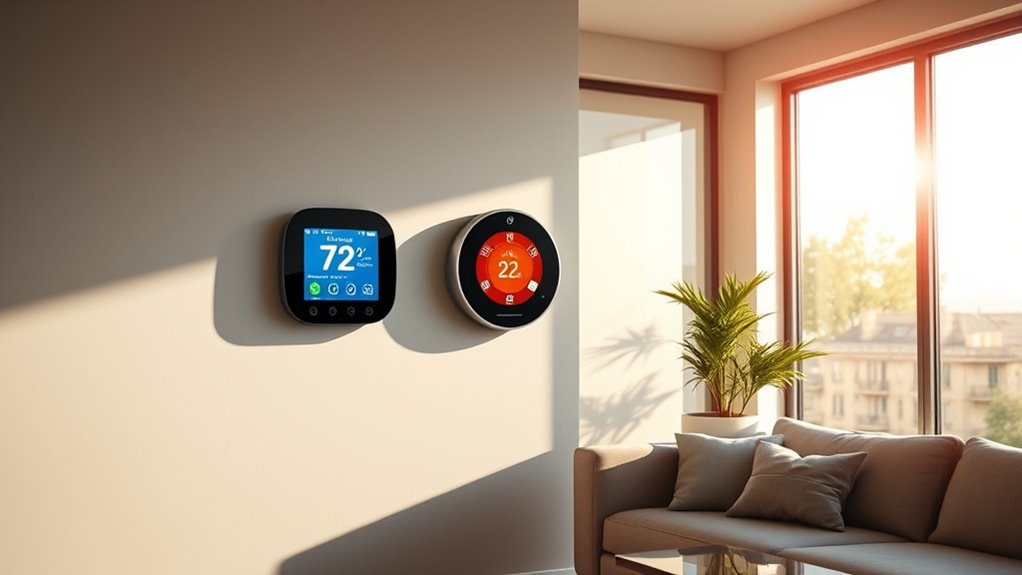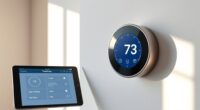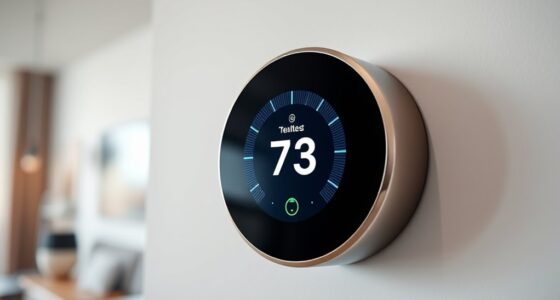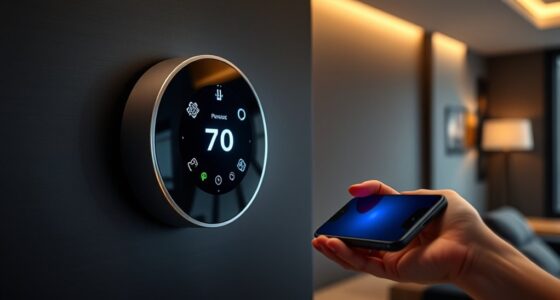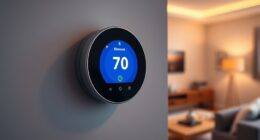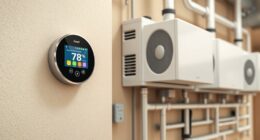If you want to cut your utility bills with better home climate control, I recommend exploring top smart thermostats like the Google Nest Learning Thermostat, ecobee models with sensors, and user-friendly options like Emerson Sensi. These devices boost energy savings through auto-scheduling, occupancy detection, and remote control. They’re compatible with popular smart home systems and offer easy installation. Keep going to learn more about choosing the best model for your needs and maximizing savings.
Key Takeaways
- Many models, like ecobee and Nest, offer advanced scheduling and learning features to optimize energy use and reduce utility bills.
- ENERGY STAR-certified thermostats can save up to 26% annually on heating and cooling costs.
- Features such as occupancy sensors, geofencing, and auto-away modes enhance energy efficiency by adjusting settings based on presence.
- Compatibility with voice assistants and smart home ecosystems allows for seamless automation and remote control.
- Easy DIY installation and user-friendly interfaces make it simple to set up and maximize energy savings.
Amazon Smart Thermostat
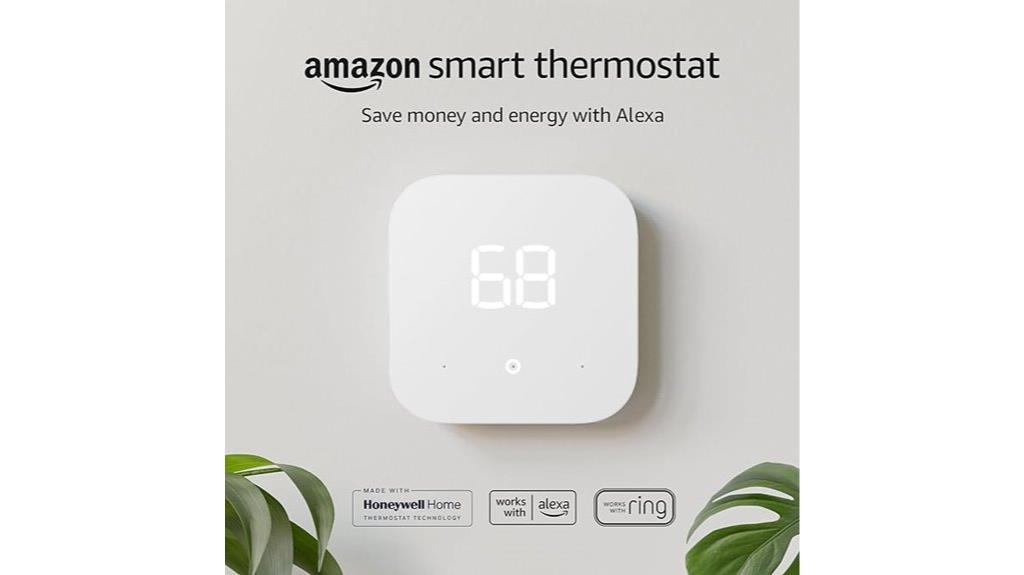
Are you looking for an easy way to cut your energy bills while enjoying smart home convenience? The Amazon Smart Thermostat makes upgrading simple, especially if your home has a C-wire. It works seamlessly with Alexa and Ring devices, allowing voice control and easy automation. You can monitor and adjust your temperature remotely using the Alexa app, saving energy and money. With ENERGY STAR certification, it can save around $50 annually on bills. Installation is straightforward with guided support, and its durable Honeywell technology guarantees reliable performance. Plus, you might find rebates from your energy provider to make it even more affordable.
Best For: homeowners seeking an easy-to-install, energy-saving smart thermostat that integrates seamlessly with Alexa and Ring devices.
Pros:
- Supports C-wire installation for straightforward setup
- Compatible with Alexa and Ring for voice control and automation
- Can save approximately $50 annually on energy bills with ENERGY STAR certification
Cons:
- Limited to homes with a compatible C-wire setup
- May require additional sensors for optimal temperature coverage in larger or multi-zone homes
- Dependence on Wi-Fi connectivity for remote control and automation features
Google Nest Learning Thermostat (4th Gen, 2024) with Nest Temperature Sensor
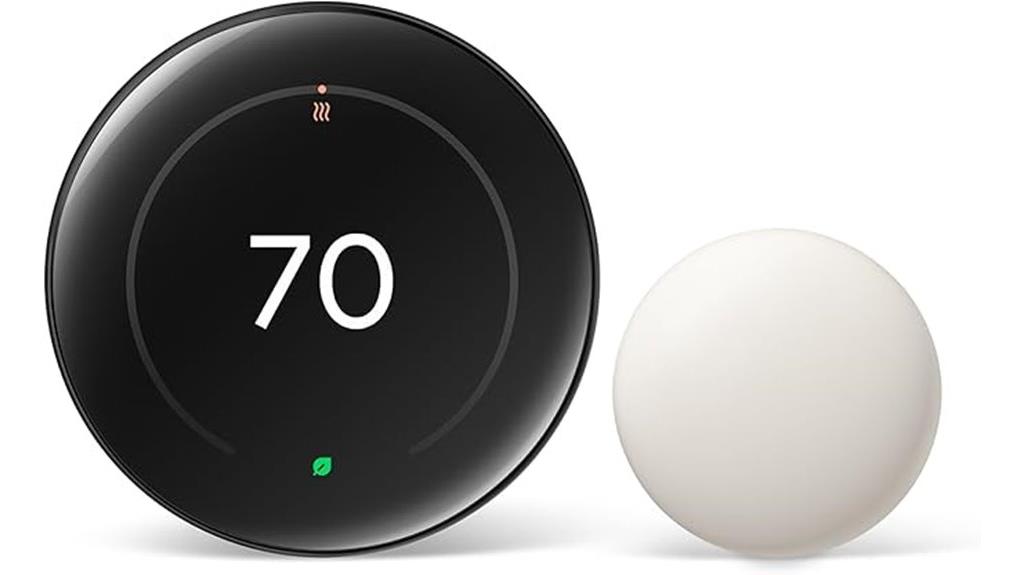
The Google Nest Learning Thermostat (4th Gen, 2024) with Nest Temperature Sensor is an excellent choice for homeowners seeking to maximize energy savings with minimal effort. Its sleek Obsidian finish and larger display with Dynamic Farsight make it both stylish and functional, allowing you to see key info from across the room. It easily integrates with systems like Alexa, Google Assistant, and Apple HomeKit, offering remote control via the Google Home app. The thermostat learns your habits and suggests schedule adjustments, helping you save around 12% on heating and 15% on cooling bills. Plus, with compatible sensors, it manages hot and cold spots for ideal comfort and efficiency.
Best For: homeowners seeking a stylish, smart, and energy-efficient thermostat that easily integrates with popular smart home ecosystems.
Pros:
- Larger display with Dynamic Farsight for easy viewing from across the room
- Seamless compatibility with Alexa, Google Assistant, Apple HomeKit, and Matter
- Learns user habits and suggests schedule adjustments to maximize energy savings
Cons:
- May require a C wire for certain installation setups
- Learning curve for new users unfamiliar with smart thermostats
- Cost may be higher compared to basic thermostats without smart features
ecobee Smart Thermostat Essential with Wi-Fi and Voice Assistants
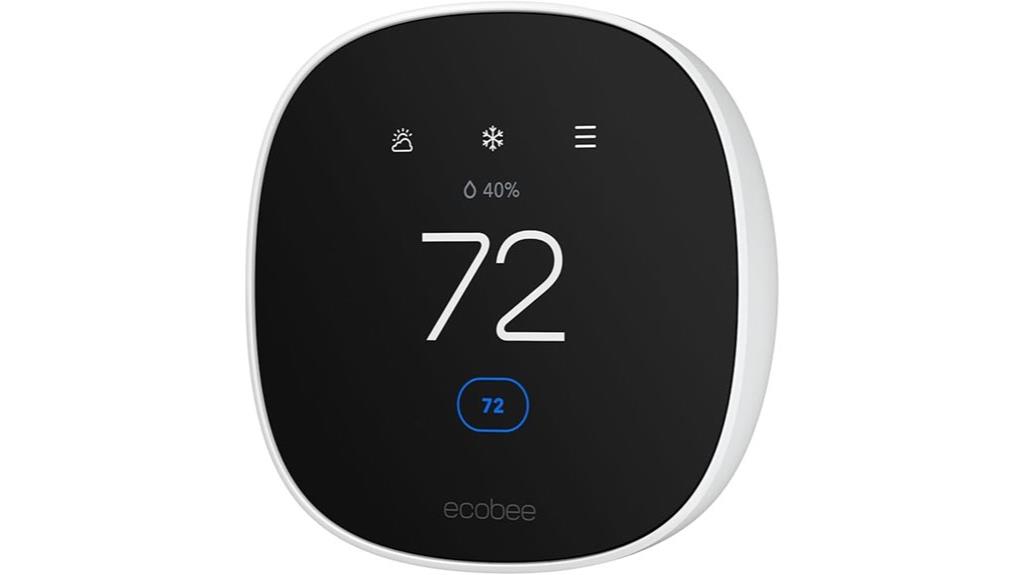
If you’re looking for an easy-to-install smart thermostat that delivers substantial energy savings, the ecobee Smart Thermostat Essential with Wi-Fi and Voice Assistants stands out. It’s Energy Star certified and compatible with Siri, Alexa, Google Assistant, and Apple HomeKit, making integration seamless. The device features an LCD display, touch controls, auto-scheduling, and fan management, optimizing your HVAC for maximum efficiency. Many users save up to 23% on energy bills, often recouping the cost within six months. Its straightforward installation and app control make it perfect for DIYers seeking reliable, modern home upgrades that cut utility costs.
Best For: homeowners or DIY enthusiasts seeking an easy-to-install, energy-efficient smart thermostat compatible with popular voice assistants and smart home ecosystems.
Pros:
- Easy installation with straightforward setup, suitable for DIYers
- Energy savings of up to 23%, quickly offsetting the purchase cost
- Compatible with multiple voice assistants and smart home platforms for seamless integration
Cons:
- Limited scheduling flexibility, allowing only one schedule per season
- Cannot set different schedules for different seasons without manual re-entry
- Scheduling intervals are restricted to 30-minute blocks, not customizable to minutes
ecobee Smart Thermostat Enhanced, Wifi Thermostat with Voice Assistant Compatibility
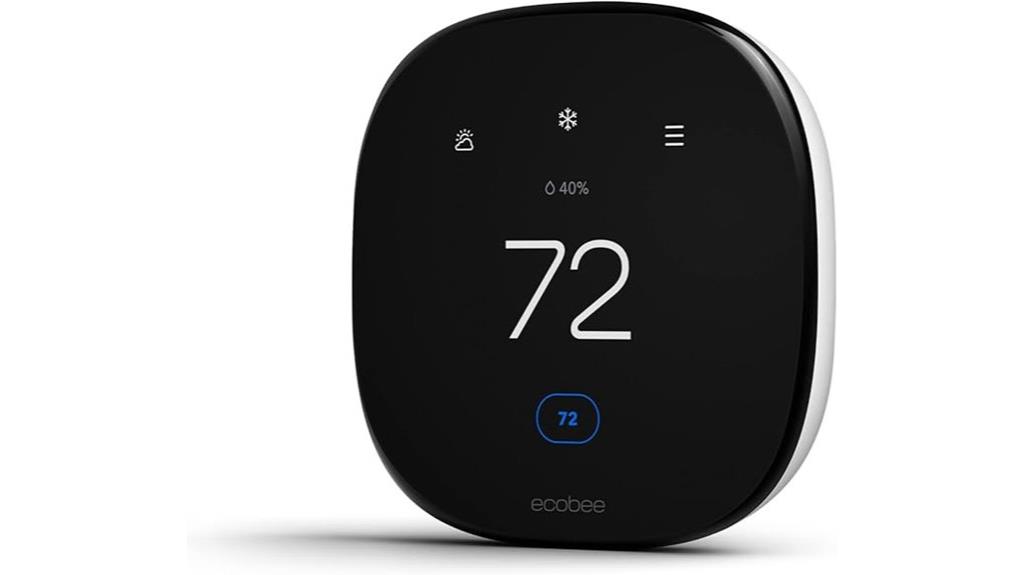
For homeowners seeking to cut energy costs without sacrificing comfort, the ecobee Smart Thermostat Enhanced offers an intelligent solution. It can save up to 26% annually on heating and cooling by automatically adjusting the temperature when you’re away and preconditioning your home before arrival. The thermostat also monitors humidity and uses SmartSensor technology to focus on key rooms for ideal comfort. Compatible with Siri, Alexa, Google Assistant, and other platforms, you can control it remotely via the ecobee app or voice commands. Its easy installation, energy-efficient features, and compatibility with most HVAC systems make it a smart upgrade for any home.
Best For: homeowners seeking to reduce energy costs while maintaining customizable, smart home comfort and control.
Pros:
- Saves up to 26% annually on heating and cooling costs through intelligent adjustments.
- Compatible with major voice assistants and smart home platforms for seamless control.
- Easy to install, even without a traditional C-wire, with a user-friendly interface and reliable performance.
Cons:
- Requires Wi-Fi connection for full functionality, which may be a concern in areas with poor internet.
- Advanced features like SmartSensor may require additional purchase or setup.
- Compatibility with certain older HVAC systems might be limited, necessitating professional assessment.
Meross Smart Thermostat for Home
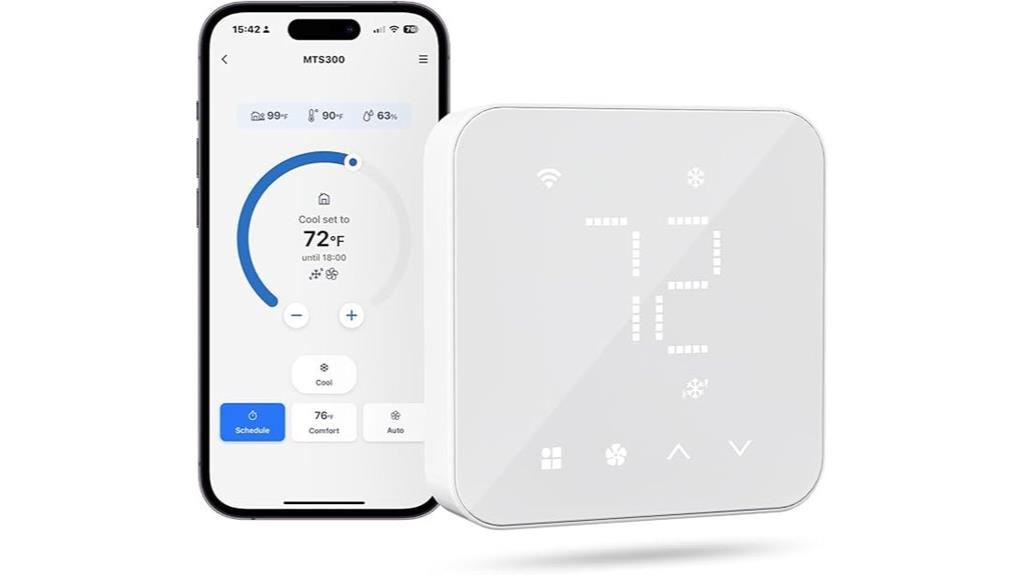
With compatibility for 95% of HVAC systems, the Meross Smart Thermostat is an excellent choice for homeowners seeking easy, reliable energy savings. It works with most heating, cooling, and heat pump systems, but not electric baseboard heaters. You’ll need a C-wire for proper installation, or a Meross adapter if it’s missing. The thermostat supports 2.4GHz Wi-Fi and offers customizable 7×24-hour schedules that run even without internet. It integrates seamlessly with Apple Home, Alexa, Google, and Samsung SmartThings through Matter technology, enabling voice control. Plus, you can remotely monitor and adjust settings via the app to optimize comfort and efficiency.
Best For: homeowners seeking an easy-to-install, energy-efficient smart thermostat compatible with most HVAC systems and smart home platforms.
Pros:
- Compatible with 95% of HVAC systems, including heat pumps and conventional setups
- Supports customizable 7×24-hour scheduling that functions offline for consistent comfort
- Seamless integration with Apple Home, Alexa, Google, and Samsung SmartThings via Matter technology
Cons:
- Not compatible with electric baseboard heaters
- Requires a C-wire for installation or the purchase of a Meross adapter if absent
- Only supports 2.4GHz Wi-Fi networks, limiting compatibility with 5GHz networks
Honeywell Wi-Fi Smart Color Thermostat
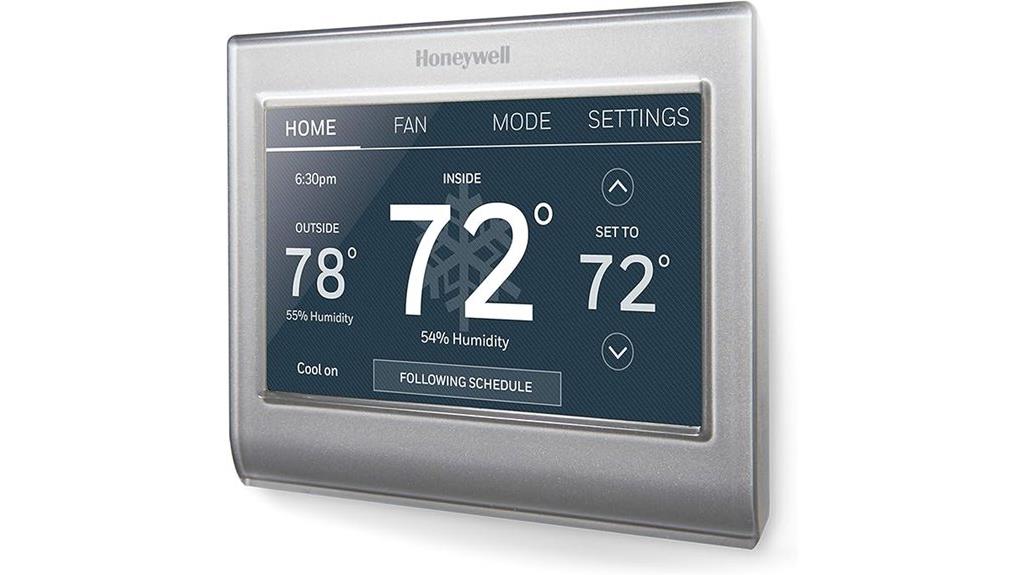
The Honeywell Wi-Fi Smart Color Thermostat stands out for its customizable full-color touchscreen and advanced scheduling features, making it it ideal for homeowners seeking precise control and energy efficiency. It offers a 7-day programmable schedule and supports systems like central air, heat pumps, and auxiliary heat. With Alexa compatibility and remote Wi-Fi access, managing your home climate is effortless. The device displays indoor temperature, outdoor weather, humidity, and forecasts, providing all-encompassing control. Its intuitive interface and sleek design are highly praised, though installation can be tricky for some due to delicate wiring. Overall, it’s a reliable choice for those wanting smart, customizable, and energy-saving thermostat features.
Best For: homeowners seeking a customizable, energy-efficient smart thermostat with full-color touchscreen and remote control capabilities.
Pros:
- Intuitive and responsive color touchscreen interface for easy control
- Supports multiple HVAC systems, including heat pumps and auxiliary heat
- Seamless integration with Alexa, SmartThings, Google Home, and IFTTT for voice and app control
Cons:
- Installation can be challenging due to fragile wire connectors requiring careful handling
- Limited fan control options (ON, AUTO, CIRCULATING) may not suit all preferences
- Humidity readings can lag or vary, affecting climate management accuracy
Sensi Smart Thermostat with Wi-Fi and Mobile App
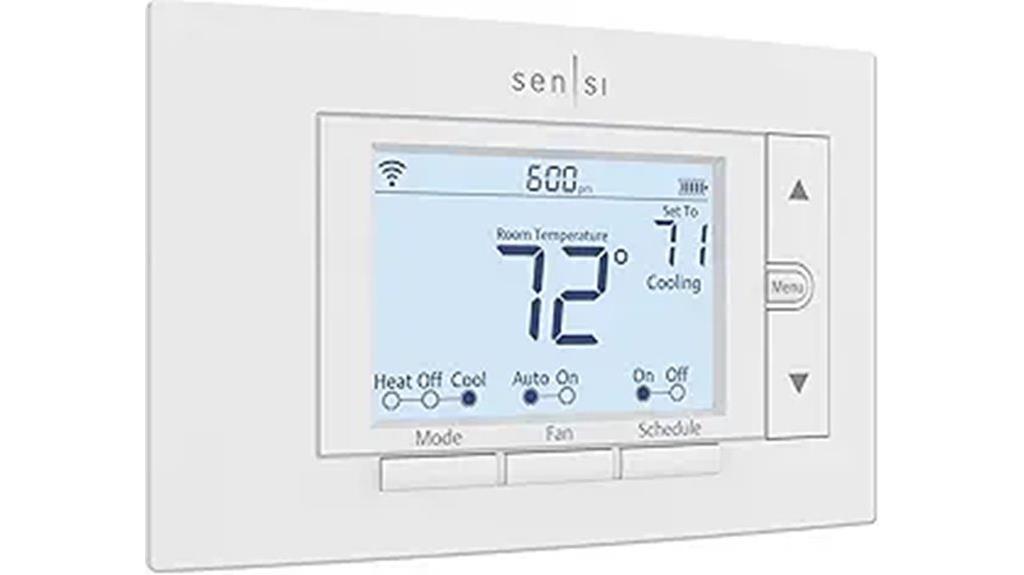
If you’re looking to cut energy costs without sacrificing comfort, the Sensi Smart Thermostat with Wi-Fi and Mobile App is an excellent choice. It offers easy DIY installation, fitting the same space as traditional thermostats, and works with most HVAC systems, often without needing a c-wire. Features like programmable scheduling, remote control, filter alerts, and humidity management help save around 23% on energy bills. Its sleek LED display and intuitive app make setup and daily adjustments straightforward. Compatibility with voice assistants like Alexa and Google Assistant adds convenience. Backed by a three-year warranty and reliable performance, the Sensi thermostat makes energy savings simple and accessible.
Best For: homeowners seeking an easy-to-install, energy-efficient smart thermostat compatible with most HVAC systems and voice assistants.
Pros:
- Easy DIY installation with step-by-step app guidance and hardware included
- Energy Star certified, helping to reduce HVAC energy bills by approximately 23%
- Compatible with Alexa, Google Assistant, SmartThings, and Vera for voice control
Cons:
- Limited detailed usage data and insights available through the app
- Occasional connectivity or setting adjustment issues reported by some users
- No support for Bixby voice commands and limited advanced customization features
Vine Smart Thermostat with Touchscreen Display
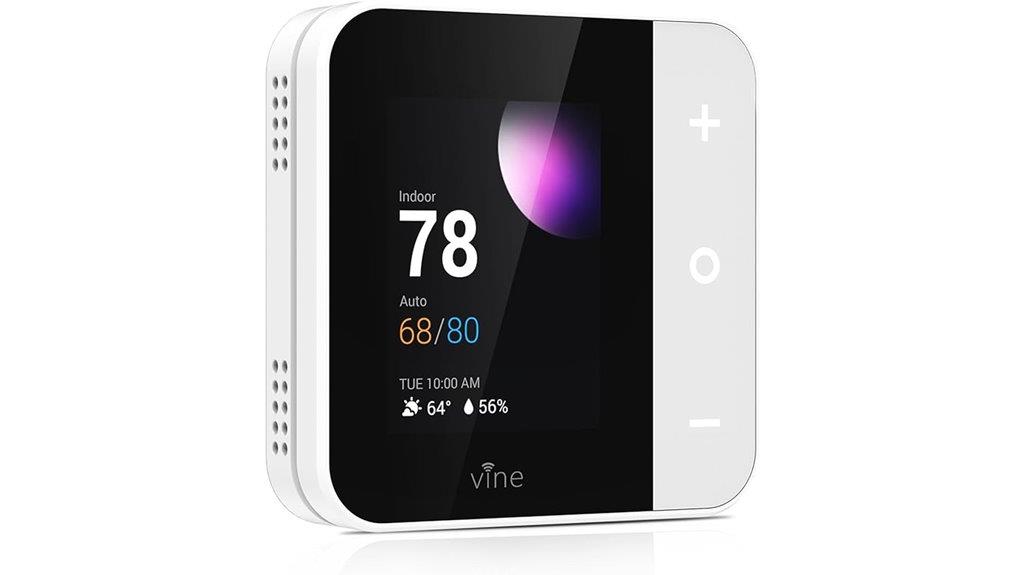
Looking for a smart thermostat that’s easy to install and compatible with most home systems? The Vine Smart Thermostat fits the bill, supporting 90% of system types like conventional, heat pump, gas, electric, and more. Installation is quick, usually done within 20 minutes with clear online guides. You can control and monitor it remotely through the Vine or Smart Life apps, and it works seamlessly with Alexa and Google Assistant for voice commands. Its 2.8-inch touchscreen makes adjustments simple, while features like 7-day scheduling, auto home/away, and ENERGY STAR certification help save energy and cut utility bills.
Best For: homeowners seeking an easy-to-install, versatile smart thermostat compatible with most home heating and cooling systems, offering remote control and energy-saving features.
Pros:
- Supports 90% of system types, including conventional, heat pump, gas, electric, and more.
- Quick installation process typically completed within 20 minutes with online guides.
- Compatible with voice assistants like Alexa and Google Assistant for hands-free control.
Cons:
- Requires a common C-wire for installation, which may not be available in all systems.
- The 2.8-inch touchscreen, while functional, may be small for some users compared to larger displays.
- Limited to Wi-Fi connectivity, so internet issues could affect remote control capabilities.
Sensi Lite Smart Thermostat
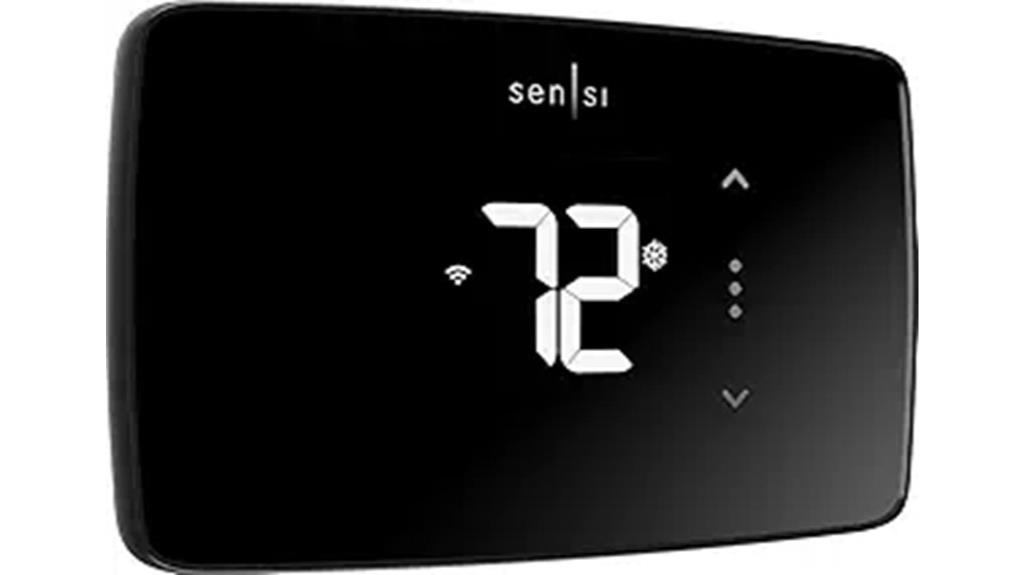
Are you seeking an easy-to-install smart thermostat that can help you save energy without complicated setup? The Sensi Lite Smart Thermostat by Emerson is a great choice. It’s Energy Star certified, simple to install, and compatible with most HVAC systems, including boilers, heat pumps, and air conditioners. With a clear LCD display and app control via Wi-Fi, you can set schedules, monitor usage, and adjust temperatures remotely. It works seamlessly with Alexa, Google Assistant, and SmartThings. Most users find the setup straightforward, especially since it doesn’t require a C-wire in many cases. Plus, it promises about 23% energy savings, making it a budget-friendly upgrade.
Best For: homeowners seeking an easy-to-install, energy-saving smart thermostat compatible with a variety of HVAC systems and voice assistants.
Pros:
- Simple DIY installation with clear instructions and minimal wiring needs
- Supports remote control and scheduling via Wi-Fi app, compatible with Alexa, Google Assistant, and SmartThings
- Energy Star certified, offering approximately 23% HVAC energy savings
Cons:
- May experience connectivity issues after power outages or battery changes requiring troubleshooting
- Limited scheduling flexibility and app statistics compared to more advanced models
- Not recommended for use outside the US/Canada and may require additional wiring or adapters for certain systems
ecobee Smart Sensor 2 Pack for Smart Thermostats
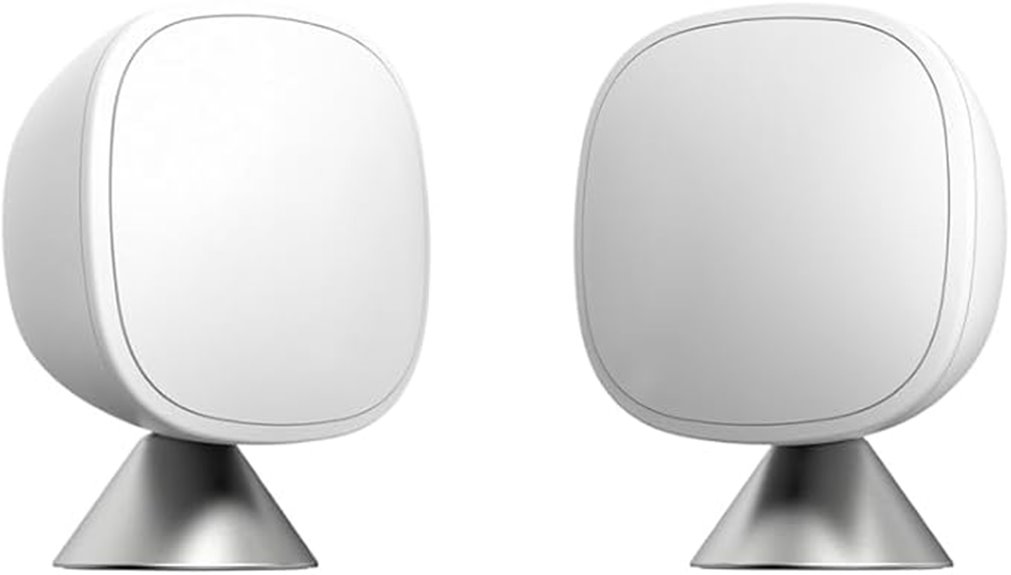
The ecobee Smart Sensor 2 Pack is ideal for homeowners who want to maximize energy savings and enhance home comfort. These sensors monitor room occupancy and temperature within 60 feet, communicating with your ecobee thermostat through walls and floors. By detecting when rooms are unoccupied, they help prevent unnecessary heating or cooling, lowering energy bills. Placement is straightforward—they can be magnetically attached or wall-mounted at least 5 feet above the floor. Plus, they provide real-time temperature data, ensuring your home stays comfortable. With security features like motion alerts when Smart Security is enabled, these sensors offer both efficiency and peace of mind.
Best For: homeowners seeking to maximize energy efficiency and home comfort through easy-to-install smart sensors that monitor occupancy and temperature.
Pros:
- Easy to install with magnetic attachment or wall-mounting options
- Provides real-time occupancy and temperature data for personalized comfort
- Enhances home security with motion alerts during Smart Security mode
Cons:
- Requires a subscription for advanced security features like motion alerts
- Effectiveness depends on proper placement at least 5 feet above the floor
- Limited communication range of 60 feet may require multiple sensors for larger homes
Honeywell WiFi Smart Thermostat RTH8800WF2022
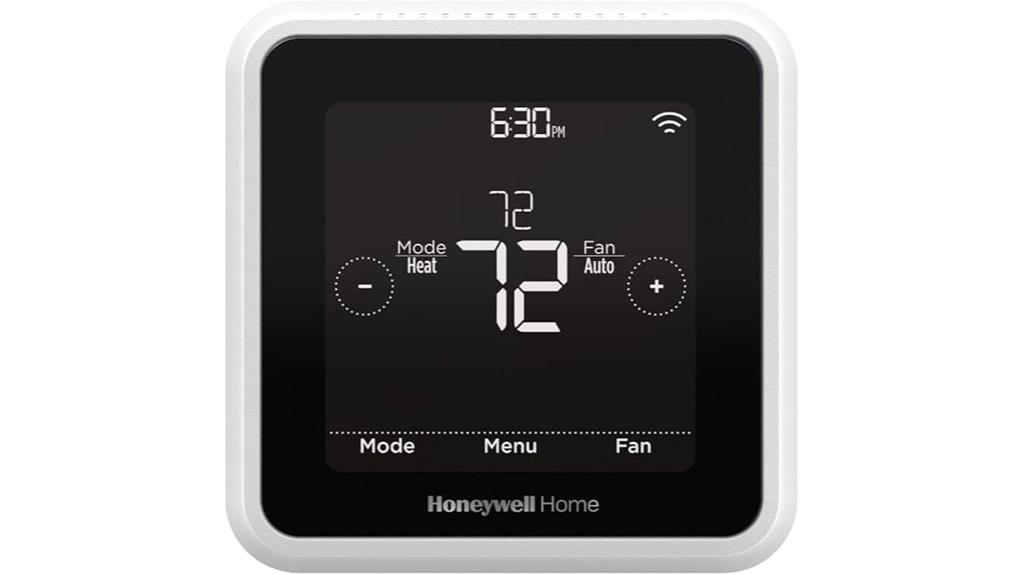
If you want a smart thermostat that combines flexible scheduling with energy-saving features, the Honeywell WiFi Smart Thermostat RTH8800WF2022 is an excellent choice. It offers a 7-day programmable touchscreen, supports most heat/cool systems, and is Alexa compatible. Its geofencing technology adjusts the temperature based on your location, saving energy when you’re away. Customers have reported saving 8-16% on heating and cooling bills. Plus, it’s ENERGY STAR certified, promoting efficiency. Just remember, a C-wire is required for power, and it’s not compatible with heating-only oil systems unless you have the adapter. It’s a smart, user-friendly option for energy-conscious homeowners.
Best For: homeowners seeking a flexible, energy-efficient smart thermostat compatible with various heating/cooling systems and voice control.
Pros:
- Supports 7-day programmable scheduling and geofencing for personalized comfort and energy savings
- ENERGY STAR certified, promoting energy efficiency and potential rebates
- Easy to use touchscreen interface with Alexa voice compatibility
Cons:
- Requires a C-wire power adapter for proper installation
- Not compatible with heating-only oil systems unless a C-wire adapter is used
- Setup may be complex for those unfamiliar with smart thermostat wiring
ecobee Smart Thermostat Premium with Sensors and Air Quality Monitor
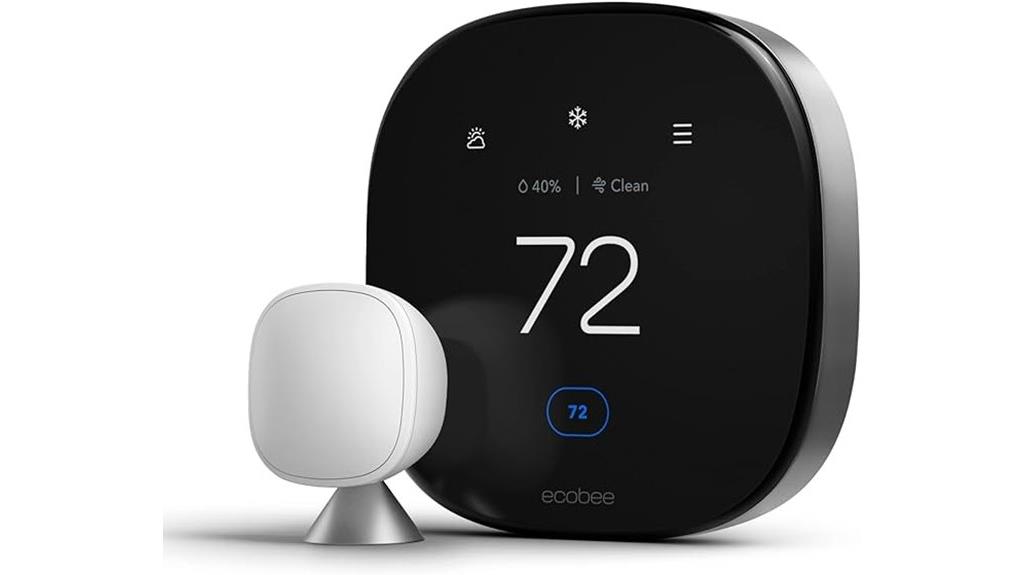
The ecobee Smart Thermostat Premium with Sensors and Air Quality Monitor stands out as the ideal choice for homeowners seeking both energy savings and healthier indoor environments. It can save you up to 26% annually on heating and cooling costs and is ENERGY STAR certified. The included SmartSensor adjusts temperatures in key rooms, reducing hot and cold spots, while the built-in air quality monitor alerts you to poor air quality and reminds you to change filters. With sleek design, advanced occupancy sensing, and compatibility with most HVAC systems, it also acts as a safety hub with smoke detection and security alerts. Voice control via Siri or Alexa makes it both smart and convenient.
Best For: homeowners seeking to optimize energy savings, improve indoor air quality, and integrate smart home features seamlessly.
Pros:
- Up to 26% annual savings on heating and cooling costs with ENERGY STAR certification.
- Advanced air quality and environmental monitoring, including filter change reminders and air quality alerts.
- Stylish design with a large display, voice control options, and compatibility with most HVAC systems.
Cons:
- Requires a subscription to the ecobee Smart Security plan to access security features.
- Apple Home Hub is needed for Siri integration, which may add extra setup complexity.
- Some features, like security alerts, depend on system arming and may not be available without proper configuration.
Google Nest Thermostat, Smart Wi-Fi Thermostat for Home
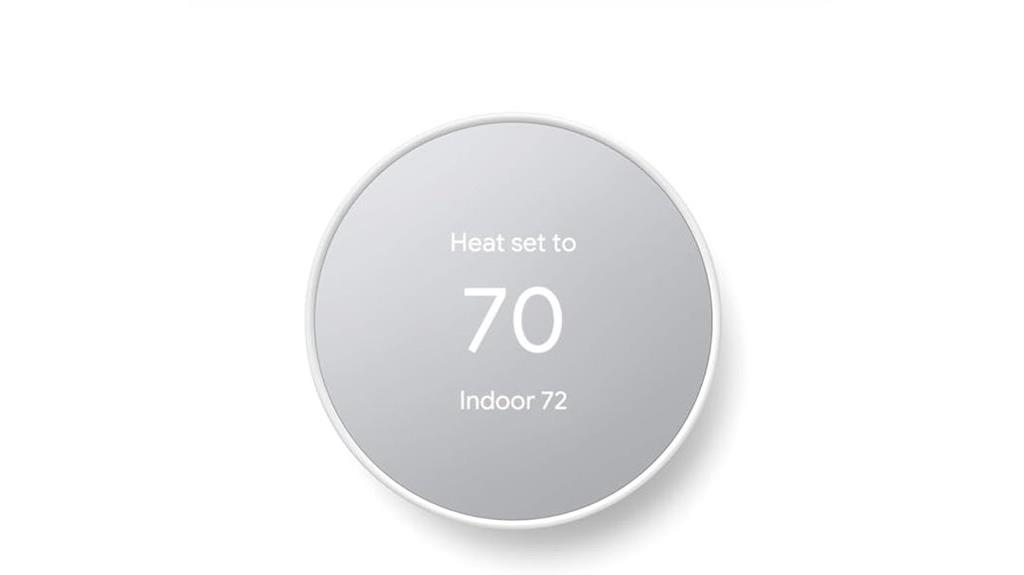
For homeowners seeking an easy-to-install smart thermostat that actively reduces energy bills, the Google Nest Thermostat stands out. It’s ENERGY STAR certified and adjusts itself when you’re away, saving energy automatically. Supporting heating, cooling, and heat pump systems, it’s easy to set up in about 30 minutes, with a sleek LCD display and app control. Compatible with Google Assistant, Alexa, iOS, and Android, it offers remote management and voice commands. Its learning capabilities optimize your schedule over time, helping cut costs. Plus, it monitors system health and provides maintenance alerts, making it a convenient, energy-saving upgrade for any smart home.
Best For: homeowners looking for an easy-to-install, energy-saving smart thermostat that integrates seamlessly with voice assistants and smart home systems.
Pros:
- Easy DIY installation typically completed within 30 minutes
- Supports a variety of HVAC systems and offers remote control via mobile app and voice commands
- ENERGY STAR certified, with features that promote energy savings and monitor system health
Cons:
- Some users experience difficulties with wiring and system compatibility during setup
- Limited offline functionality, relying heavily on internet connectivity
- Initial setup instructions may lack detailed guidance, leading to potential troubleshooting challenges
Emerson Sensi Touch Wi-Fi Smart Thermostat
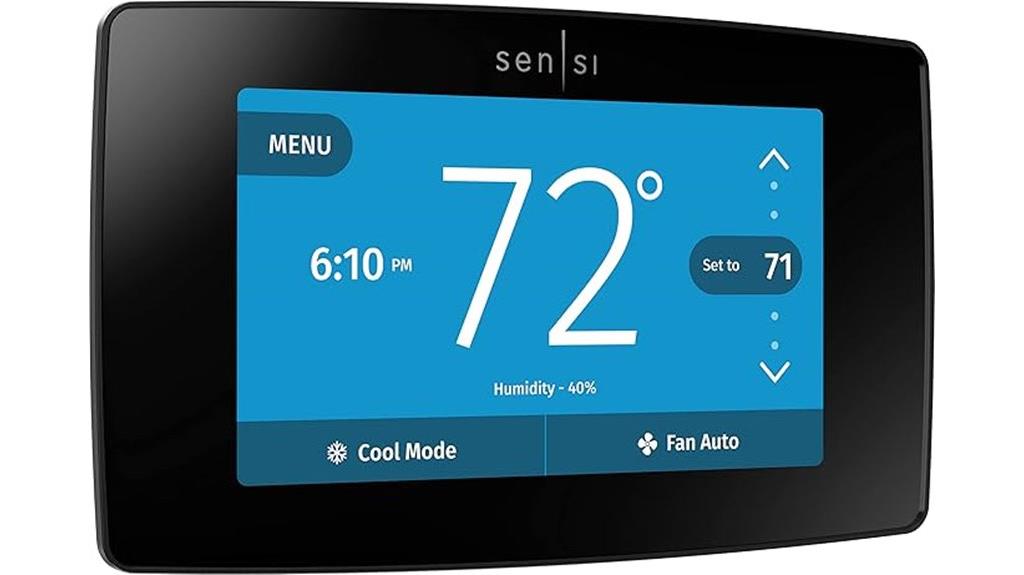
The Emerson Sensi Touch Wi-Fi Smart Thermostat stands out with its large 4.3-inch color touchscreen, making it ideal for users who want a sleek, easy-to-read display and intuitive control. It’s Energy Star certified, helping you save around 23% on HVAC energy through flexible scheduling, remote access, and detailed usage reports. Compatible with various HVAC systems and supporting voice control via Alexa, Google Assistant, and Apple HomeKit, it offers both manual and app control. Easy to install with a common C-wire, it provides features like filter alerts, geofence technology, and auto changeover, making it a reliable choice for energy savings and system monitoring.
Best For: Homeowners seeking an easy-to-use, energy-efficient smart thermostat with a sleek display and versatile control options.
Pros:
- Large 4.3-inch color touchscreen for clear, intuitive interaction
- Energy Star certified, offering approximately 23% savings on HVAC energy
- Supports multiple control methods including app, voice commands, and manual touch
Cons:
- Requires a common C-wire for full functionality; no battery-only operation available
- Registration and remote control features can be limited outside North America
- Basic compatibility with Apple HomeKit, with some functionalities potentially limited outside the US and Canada
meross Smart Thermostat for Electric Baseboard and In-Wall Heaters
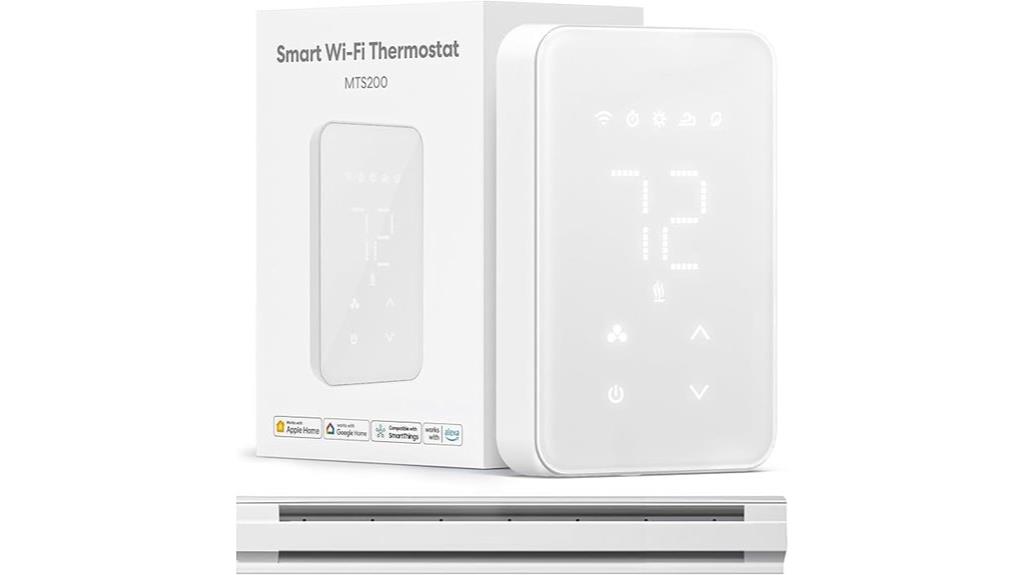
If you want to optimize energy use in your home’s electric baseboard or in-wall heaters, the meross Smart Thermostat stands out as an excellent choice. Installation is quick—under 30 minutes—and it works with various high-voltage systems up to 16A. It supports voice control through Siri, Alexa, Google Assistant, and SmartThings, making adjustments effortless. The app allows you to set detailed schedules and monitor real-time energy consumption, helping you conserve on bills. Its sleek LCD display ensures precise temperature control with 1°F accuracy, and the open window detection feature prevents wasted energy, maximizing efficiency and comfort.
Best For: homeowners seeking an easy-to-install, energy-efficient smart thermostat compatible with electric baseboard and in-wall heaters.
Pros:
- Quick installation in under 30 minutes with compatibility for various high-voltage systems
- Supports multiple voice assistants including Siri, Alexa, Google Assistant, and SmartThings for hands-free control
- Offers detailed scheduling, real-time energy monitoring, and open window detection to maximize efficiency
Cons:
- Requires at least four wires in the electrical box, which may not be available in all setups
- Electric baseboard heater not included, so additional purchase may be necessary
- Maximum load capacity is 16A, which might not suit larger or more powerful heating systems
Factors to Consider When Choosing a Smart Thermostat for Energy Savings
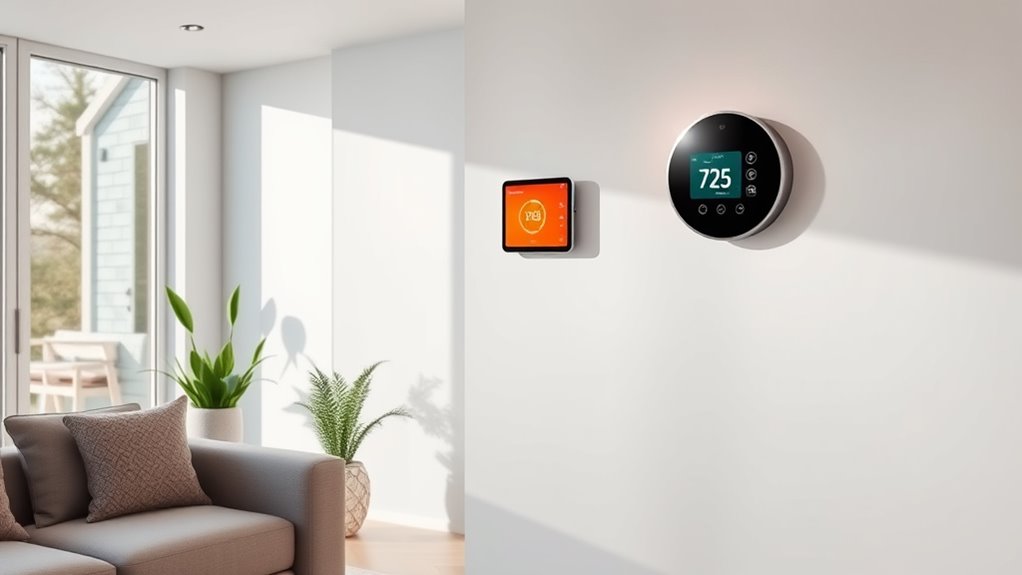
When choosing a smart thermostat, I focus on how well it works with my existing HVAC system and the energy-saving features it offers. I also consider how easy it is to install and whether it can integrate seamlessly with my smart home setup. Finally, I look at scheduling options and automation capabilities to maximize energy efficiency.
Compatibility With HVAC Systems
Choosing a smart thermostat that works seamlessly with your HVAC system requires careful attention to compatibility. First, make sure it supports your system type—gas, electric, oil, heat pump, or boiler—to guarantee proper operation. Check if your system needs a C-wire for power, especially with older or simpler setups that might not support battery-only devices. It’s also important to verify that the thermostat supports your system’s specific heating and cooling configurations, like multi-stage, zone control, or dual-fuel setups. Additionally, confirm the thermostat’s voltage compatibility; most systems use 24VAC, but high-voltage systems need specialized models. Finally, review manufacturer specifications or use compatibility tools to ensure your chosen thermostat integrates smoothly with your existing equipment and smart home ecosystem.
Energy-Saving Features Offered
Energy-saving features are the heart of a smart thermostat’s ability to reduce your energy bills and improve efficiency. Many models automatically adjust temperatures based on occupancy, schedules, or user behavior, cutting unnecessary HVAC use. Sensors or zoning capabilities help focus heating and cooling on occupied areas, preventing energy waste in empty rooms. Geofencing detects when you leave or arrive home, adjusting temperatures accordingly to save energy. Advanced thermostats analyze usage data and offer personalized recommendations or optimize schedules for maximum savings. Some devices also include humidity control and air quality monitoring, which improve comfort while maintaining efficient indoor conditions. These features work together to make sure you’re only using energy when needed, helping you cut costs without sacrificing comfort.
Ease of Installation Process
Installing a smart thermostat can seem intimidating, but many models are designed for easy setup, often taking under 30 minutes for DIY enthusiasts. Most come with step-by-step app guides, visual wiring diagrams, and mounting hardware that simplify the process and help prevent errors. Compatibility with existing HVAC wiring, especially the presence of a C-wire, is key to a smooth installation and reliable operation. Devices supporting wireless setup or quick-connect features can further streamline installation by avoiding complex wiring modifications. Clear instructions, online tutorials, and accessible customer support also make the process less daunting, even for those with limited electrical experience. Overall, choosing a thermostat with straightforward installation features ensures you can enjoy energy savings without the hassle.
Integration With Smart Home
When selecting a smart thermostat, ensuring it seamlessly integrates with your existing smart home ecosystem is essential for maximizing convenience and energy efficiency. Compatibility with popular platforms like Alexa, Google Assistant, Apple HomeKit, and SmartThings allows voice control and effortless management. Support for Matter technology further enhances interoperability, letting devices communicate across different platforms. Remote control via mobile apps means you can adjust settings and monitor your thermostat from anywhere, boosting convenience and saving energy. Integration with smart sensors and occupancy detection optimizes heating and cooling based on room usage, reducing waste. Additionally, compatibility with automation routines and schedules enables your thermostat to coordinate with other smart devices, automating home energy management for maximum savings. This seamless integration simplifies control and enhances energy efficiency.
Scheduling and Automation Options
Choosing a smart thermostat with flexible scheduling and automation options is key to maximizing energy savings. Look for models that let you create customizable weekly or daily schedules, giving you precise control over heating and cooling times. Automatic or adaptive scheduling features are especially valuable—they learn your routines and adjust temperatures automatically, reducing unnecessary energy use. Consider thermostats with automation options like geofencing, which adjusts settings based on your location, enhancing efficiency when you’re home or away. It’s also important that the thermostat allows manual overrides or temporary adjustments without disrupting your programmed routines, offering convenience. Finally, verify it supports multiple schedules per season and easy modifications, so you can adapt to changing occupancy patterns and seasonal needs for ideal energy savings.
Cost and Rebate Opportunities
Considering the costs and potential savings, it’s smart to look for energy-efficient smart thermostats that come with rebates or incentives—especially those that are ENERGY STAR certified. These certifications often qualify homeowners for rebates from local utility companies, reducing the upfront expense. Taking advantage of these programs can considerably lower the initial investment and boost your savings over time. It’s worth researching what incentives are available in your area before making a purchase. Many utility providers partner with ENERGY STAR products to promote energy efficiency, making it easier to recoup costs through rebates or discounts. By choosing a certified thermostat, you not only save money but also contribute to reducing energy consumption and environmental impact. This strategic approach maximizes your investment in energy-saving technology.
Frequently Asked Questions
How Do Smart Thermostats Impact Overall Home Energy Efficiency?
Smart thermostats considerably boost my home’s energy efficiency by learning my schedule and adjusting temperatures accordingly. I love how they optimize heating and cooling, preventing waste when I’m away or asleep. With remote control features, I can make quick adjustments from my phone. Overall, they help me save money on utility bills and reduce energy consumption, making my home more eco-friendly and comfortable at the same time.
Can Smart Thermostats Be Integrated With Existing Solar Power Systems?
Think of your smart thermostat as the conductor of your home’s energy symphony. I’ve found that many models can integrate with existing solar power systems, especially those compatible with third-party smart home platforms. By syncing them, your thermostat can optimize energy use based on solar production, reducing bills and maximizing renewable energy. Just make certain your system supports the necessary integrations, and you’re set for a more sustainable, efficient home.
What Are the Long-Term Maintenance Requirements for Smart Thermostats?
When considering long-term maintenance for smart thermostats, I find they’re pretty low-maintenance overall. I regularly update the firmware to keep everything running smoothly and ensure compatibility with other smart home devices. I also check the batteries (if battery-powered) annually and clean the device’s sensors to maintain accuracy. Usually, that’s all it takes to keep my smart thermostat functioning efficiently and helping me save on energy costs.
How Do Smart Thermostats Handle Battery Backup During Power Outages?
When power outages happen, I’ve noticed most smart thermostats handle battery backup pretty well. They usually have built-in rechargeable batteries or backup batteries that kick in during outages, allowing the thermostat to maintain settings and stay connected to Wi-Fi once power is restored. This guarantees your heating or cooling isn’t disrupted, and the device can reconnect automatically. I recommend checking each model’s backup features before buying for peace of mind.
Are There Any Privacy Concerns With Data Collection From Smart Thermostats?
Oh, privacy concerns? Who knew that your smart thermostat might be secretly plotting your daily routines! Seriously, most devices collect data to optimize performance and save energy, but they can also share info with third parties. I stay cautious by reading privacy policies and adjusting settings. Remember, it’s smart to know what data’s being collected—after all, your thermostat shouldn’t be spying on your Netflix binge!
Conclusion
Choosing the right smart thermostat can seem overwhelming, but investing in one truly pays off in energy savings and comfort. With advanced features like learning capabilities and voice control, these devices adapt seamlessly to your lifestyle, making energy efficiency effortless. Some worry about installation complexity, but many models are user-friendly and come with detailed guides. Ultimately, upgrading to a smart thermostat is a smart move for both your wallet and the environment.
